
Today we'll be looking at how to assemble the penultimate building of the new Samurai Lord's House set, the big two-storey kitchen building!
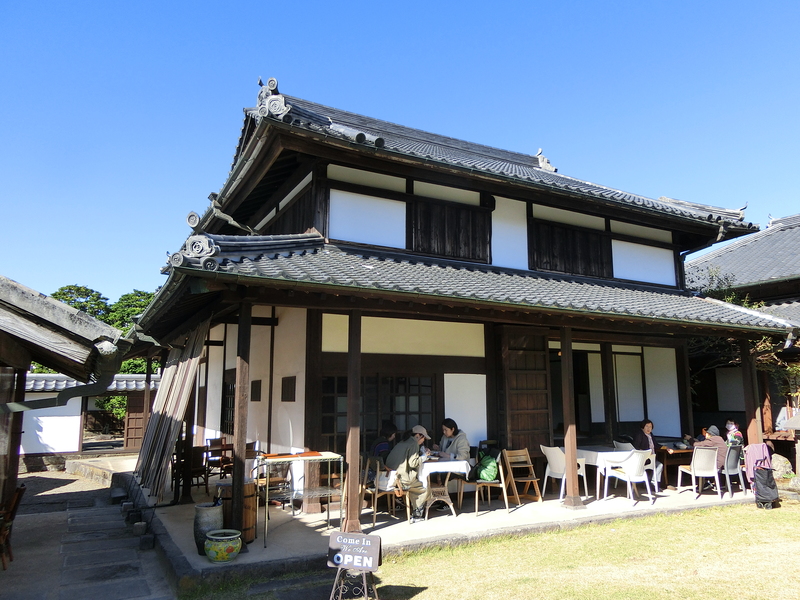
▲ Once again, I'll start by saying that this large model is based very closely on a real-life samurai lord's house in Oita prefecture, so it does have a few weird layout points! haha
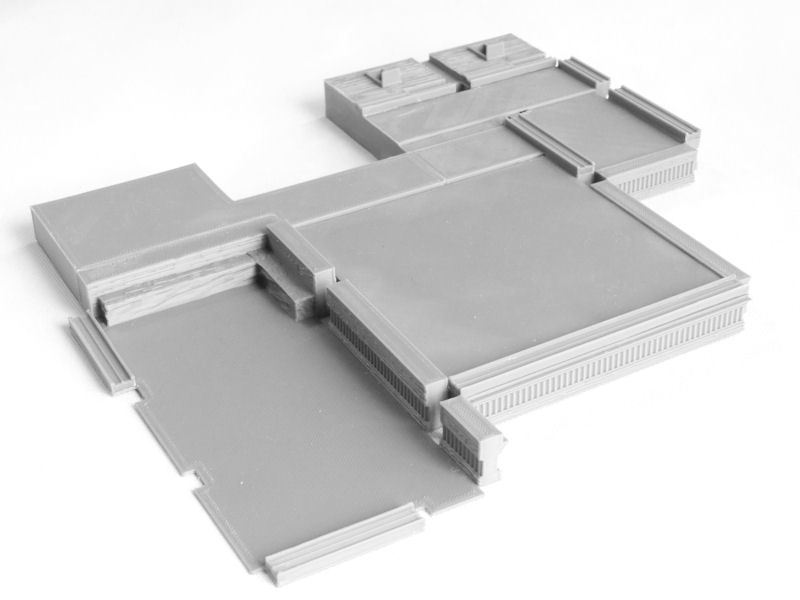
▲ We start with the four base sections, and then glue on the sliding door strips in the layout shown in the photo above.

▲ Next we're going to complete the floor sections by adding some wooden floor pieces, a special double tatami mat (it's slightly longer than normal), and whole bunch of tatami mats.
The odd little rectangluar holes at the top right of the photo, by the way, are actually toilet cubicles - which were simple holes in the floor, that dropped into a stone channel underneath and were sluiced by running water.
You can also print some stone ovens for the lower floor area. I arranged these back to back, to give my warriors something to fight around, but you could just back them against the wall! 
▲ Yay! It's time to print the wall sections, so that the layout finally makes some sense!
This prints in four pieces, all upside down. Slicer print supports are not required (but I would recommend printing your walls "Inside-to-Outside" to help with overhangs), although you'll need to remove the built-in window supports highlighted in red in the photo above.

▲ Final touches for the first level of the building are window frames (solid versions and versions designed for use with paper are included), various sliding doors, and the stairs. Yes, the smaller rear staircase really is that terrifyingly steep in real-life!
Note the single sliding wooden doors for the toilet cubicles. Perfect for ninja attacks, eh?

▲ We now move onto the second level, which can be printed in 4 sections or if, like me (on my Ender 3 V2), you have a large enough print bed, you can print it as a single large piece with millimetres to spare!
There are numerous built-in print supports that need to be carefully removed (shown in red in the photo above), for the windows and doorways. Have fun!

▲ Floor time! The wooden floors slot in as shown, leaving that interesting open floor space above the ovens below, and then you'll need about a million tatami mats again!
The small room on the left also needs a couple of small doorway strips, and two wooden doors.
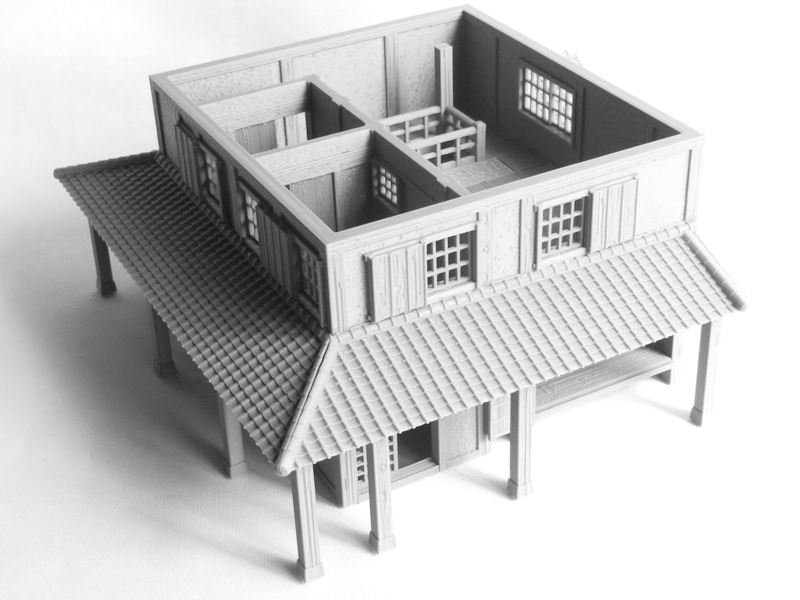
▲ You'll probably have noticed that the second level has been sliding around on top of the first level, up to this point. Fear not - by gluing the lower roof strips to the 3 sides of the upper level walls, you should find the levels will align perfectly. Hooray! These can be printed in really long sections if your printer is big enough, or half-sections for smaller printers.
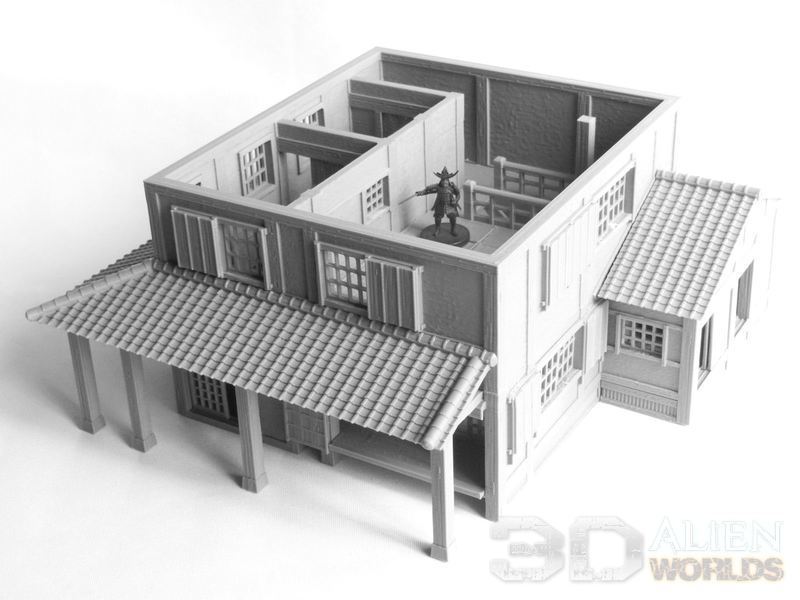
▲ If you look at the right-hand side of this photo, you'll see that there is a small gable roof over the toilets. This is actually an optional piece, and can be used to convert the kitchen building to a standalone building. I printed it so that I had a bit of extra flexibility in games, but normally I would replace it with a super-complicated connecting roof to the adjacent corridor section.
More on that later!

▲ The last step of the assembly is to print two halves of this large roof (or 4 quarters on smaller printers), and drop it on top.
Congratulations, you're finished!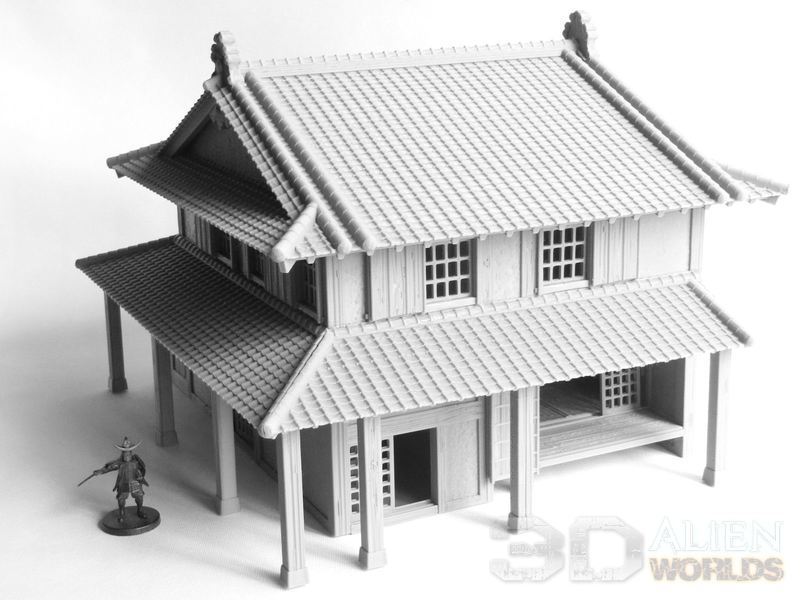
▲ Here's the completed kitchen model, with a 28mm samurai model for scale. It's pretty darn big!
Corridor:
Now seems as good a time as any to show you what the connecting corridor looks like!

▲ Assembly is a piece of cake, but you'll need to remove these two built-in print supports from the floor-level windows.

▲ Hey, somebody forgot to build the walls properly!?
Don't worry, this piece is only required if you're using all 3 main buildings together, and they all slot into place to complete the long corridor walls.
The roof, by the way, took me 3 afternoons to model! All those multiple roofline levels and angles were a complete nightmare, because I found I didn't have a clear reference photo of the roof there! So I had to get creative, and so you can rest assured that it's properly engineered - you could print it at 1:1 scale and use it on the real building!
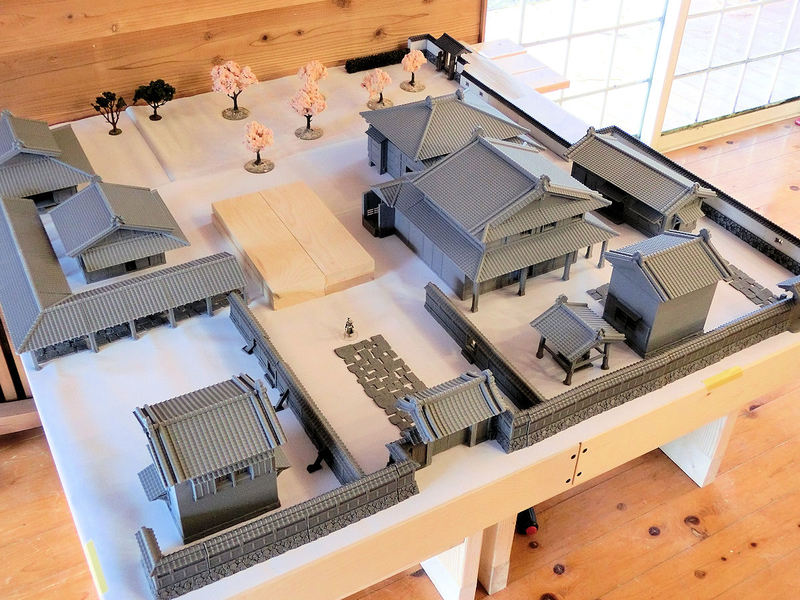
▲ So here we are, with only one more building to go! The kitchen building (on the right of the wooden blocks) is the biggest one so far, but the final main house building will dwarf even that!

▲ Yes, huge, isn't it?!

▲ This photo shows the two big buildings (kitchen and residence) connected by a corridor section....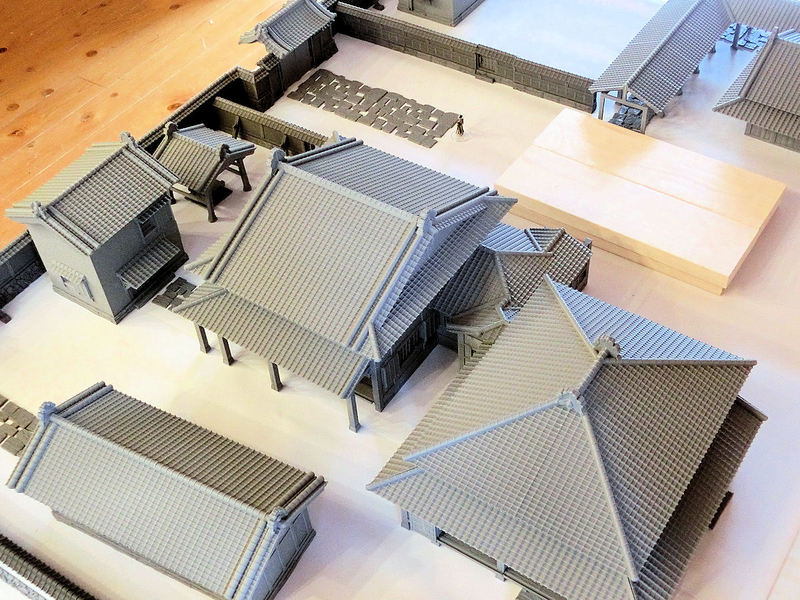
▲ ... and in this photo you get some idea of how mad that roof section is!
The big main house building is now being modelled and test-printed, so watch this space for the final layout pics!!
There are only 3 more buildings to be completed before the new Samurai Lord's House set is released, so let's take a look at how to assemble the biggest building so far - the Residence!

▲ This 4-bedroom residence building is where the Lord and his family would sleep, and although it's quite a big building the assembly process is actually quite simple and straightforward.
It starts with printing the four pieces of the building's base, labelled A~D in the photo above. On top of that, as shown in the locations in the photo, you'll need to glue the sliding door frames. There are a few of each length (long, medium and short), but the only one you need to pay attention to is the 40.5mm piece highlighted in the photo on the left. That one's just a tiny bit longer than the other short pieces. Sorry about that!

▲ The walls for the building also print in four sections, all upside-down. You don't need slicer supports for anything, but I recommend making sure that your slicer software is set to print "inside-to-outside" for the walls - this makes the overhangs work better.
There is one built-in print support on section B, for the window frame (shown in red in the picture above) which needs to be removed during assembly.

▲ You should also print the window grills and the tiny shelf piece at this point, and glue them in place.
I didn't actually glue the base sections to the wall sections yet, because they'll be much easier to paint separately.

▲ You will need to print 26 tatami mats (and 2 half-size mats), and glue them in place on the base sections as shown in the photo above. I recommend gluing these in pairs, starting with the end-to-end sides first, to retain your sanity!

▲ The last stage for the interior assembly is to print the 6 floor pieces, cut out the built-in print supports, and slot them into place around the outer balcony.
You'll also need 4 of those stone step pieces, if you want to match the location of garden exits in the real-life building.
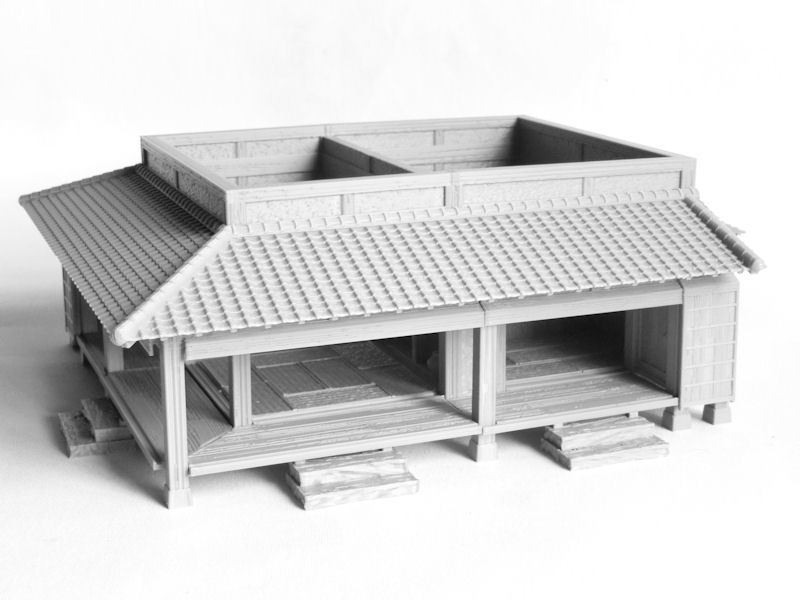
▲ Next we print the short upper level of the building, which can be printed as one piece on bigger printers, or as 4 sections on smaller ones.
The subroofs similarly can be printed in 3 pieces if your printer can handle the long sizes, or 6 half pieces if you have a smaller print bed. There is also a small roof piece that should go at the back of the building, and I glued this to the top of the lower walls (rather than the upper walls) so that it's easier to locate the subroof section when removed and replaced during gameplay.
The far side of the building actually joins onto a connecting corridor if you're using the Residence as part of the bigger House building, but you can print a non-connecting roof version instead if you want to use this Residence as a completely standalone building.

▲ Finally you should print the main roof in two halves (or 4 quarters if you have a smaller print bed), and add that on top.
Phew, we're done! With multiple exits and entrances, this building should see some serious action in skirmish games!
We have a new US retail partner to introduce to you today - Falling Star Games, from New Hampshire.
They're printing our samurai collection of terrain, so if you can't see the models you want there just drop them a line - they'd be happy to add those to the store, too! Take a look and see what they have for you!
https://www.etsy.com/shop/FallingStarGames
Today we're showing you how to print and assemble the two guesthouses from the new Samurai Lord's House set. Both of these models can be printed without slicer-created print supports, and are both stand-alone buildings, separated from the main residence via a covered walkway.
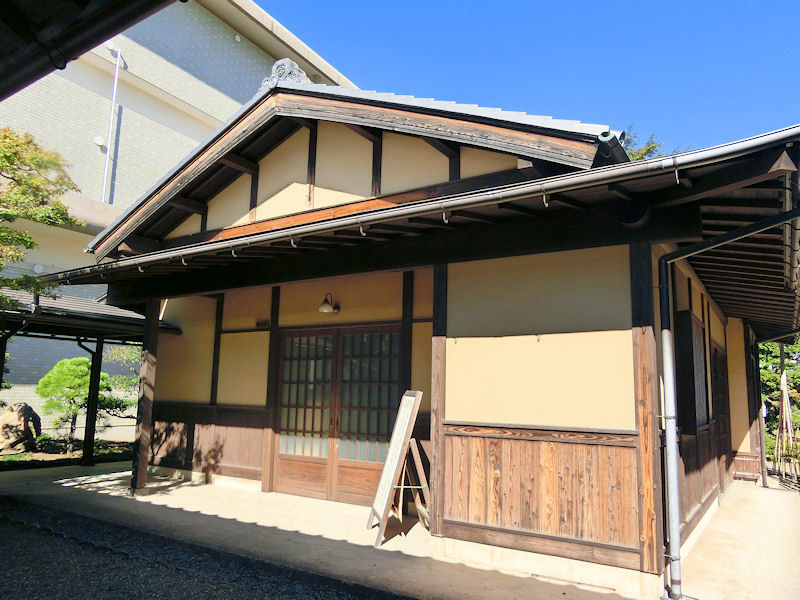
▲ Let's start with Guesthouse #1, which is perhaps the more functional of the two. This guesthouse is, like the rest of the set contents, based on an actual samurai residence in Oita prefecture (please ignore that horrible modern government building next-door!).
▲ The building itself is printed in one piece (split sections are also included for smaller printers), but does include quite a few built-in print supports in the doorways and window, which can be easily removed during assembly.
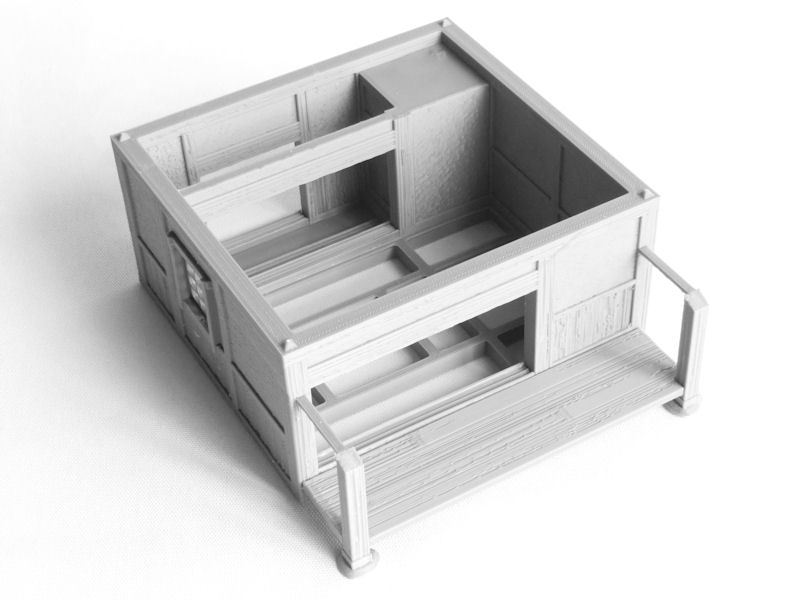
▲ Next we print a small group of extra pieces, which includes the balcony floor decking and 3 small sliding door strips, plus a choice of windows. These should be glued into place as shown in the photo above.
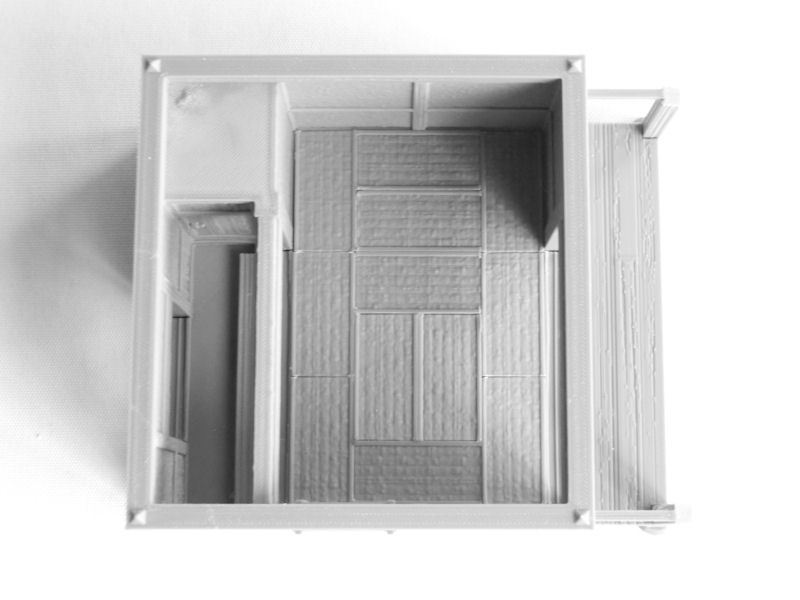
▲ This guesthouse needs 12 tatami mats, which can be squeezed into place in the layout shown above.
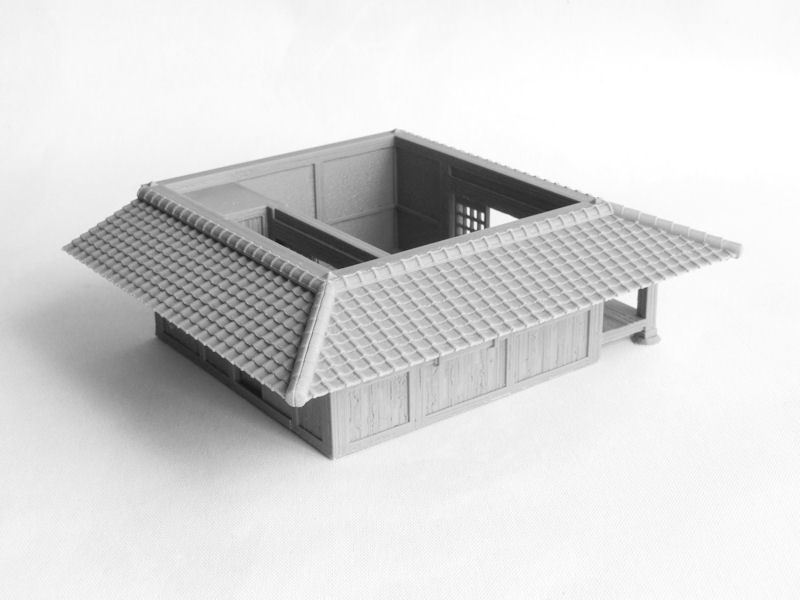
▲ There are 3 subroof pieces (and split sections for smaller printers), which should be glued into place as shown.
TIP: Glue the balcony's subroof first, as it will help to locate the other two sections properly.

▲ The main roof is printed in two halves, and there are a couple of built-in print supports on each piece (as shown in red in the photo above), which should be cut off.

▲ The last step for Guesthouse #1 is to print a couple of sliding front doors, and then decide how many sliding screen doors you'd like to include in the interior. You could use up to 8 sliding doors inside, or none at all. As always, there are two versions of each door design - the version with holes (shown above) is designed to be used with semi-transparent paper such as baking sheet.
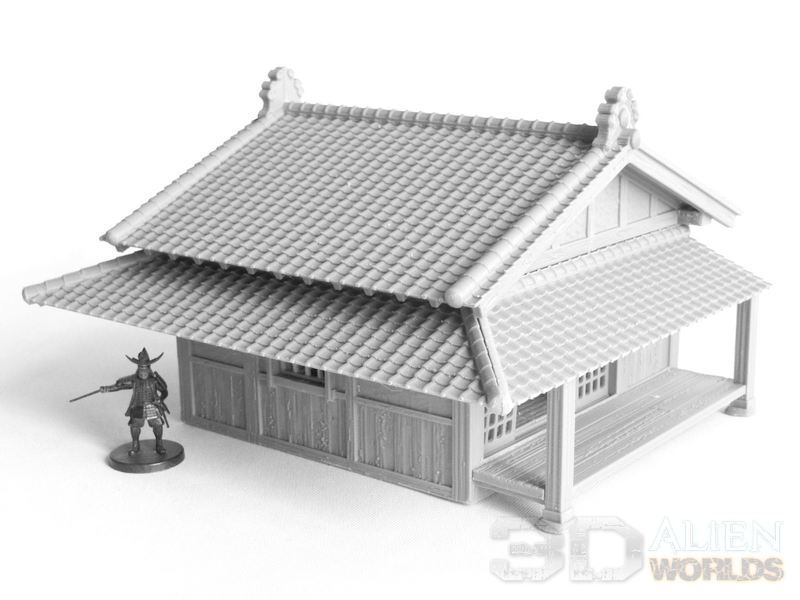
▲ This balcony faces the garden in the real-life version, with the front door closest to the main house.

▲ The interior of this first guesthouse is pretty normal, and can serve a variety of functions.

▲ Guesthouse #2 is altogether a more interesting building, and has a smaller interior room but a large wrap-around balcony on 3 sides. It also features sliding storm shutters on 3 sides.

▲ We start by printing this base section for the interior room, and gluing on the 3 sliding door strips and 8 tatami mats. The vase is part of the base piece, by the way.

▲ The main frame of the guesthouse is pretty cool, and prints completely upside down! Therefore it doesn't need any supports at all. It simply slots in place over the central base section. You should also print that little shelf piece, which can be glued into place in the alcove.
TIP: Setting your slicer to print walls "inside-to-outside" will help to ensure those overhangs will print cleanly!
The interior of this building is lovely, with that uniquely Japanese style split shelf, the small cupboard at the top with sliding doors, and the wall scroll and vase. I'll have to find something suitable to drop into that vase after I paint it!

▲ Next we will need to print the 3 floor sections and slot those into place for the internal balcony. There are tiny pegs on the frames to help you locate them properly, but you should also glue a stone step underneath each balcony to give proper support.
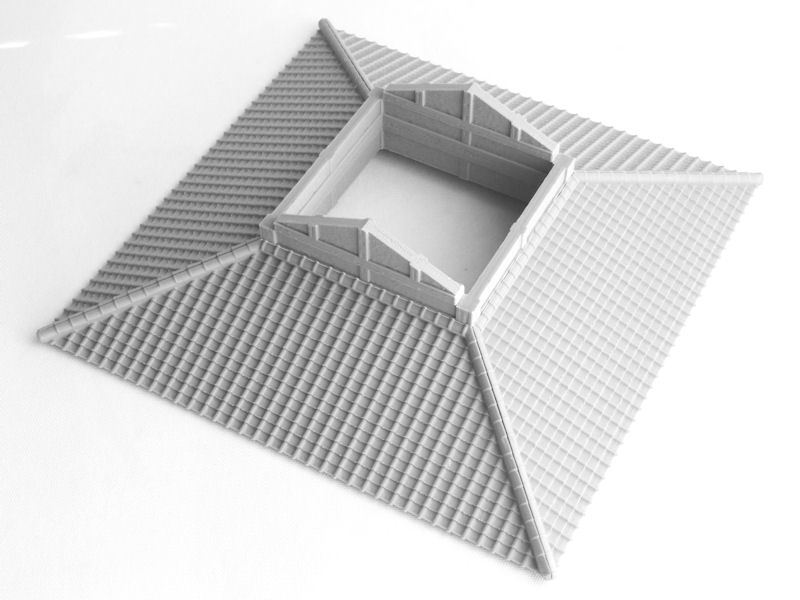
▲ The upper section of the building needs 4 subroof pieces glued in place, and I recommend gluing the side with beam supports first, as it will help to locate the subroof at the correct height.
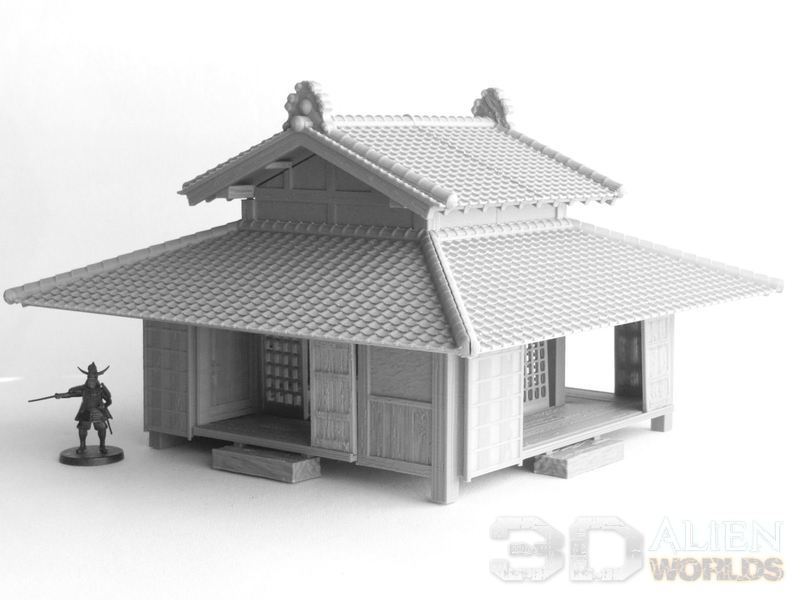
▲ The top roof prints as two halves, and has a couple of built-in print supports which need to be cut off during assembly. Then it's just a matter to deciding how many internal sliding screens (up to 12) and exterior storm shutters (up to 16!) you'd like to print. I'm only using one storm shutter on each side, I think, so that models can run through the guesthouse easily and the interior stays visible.
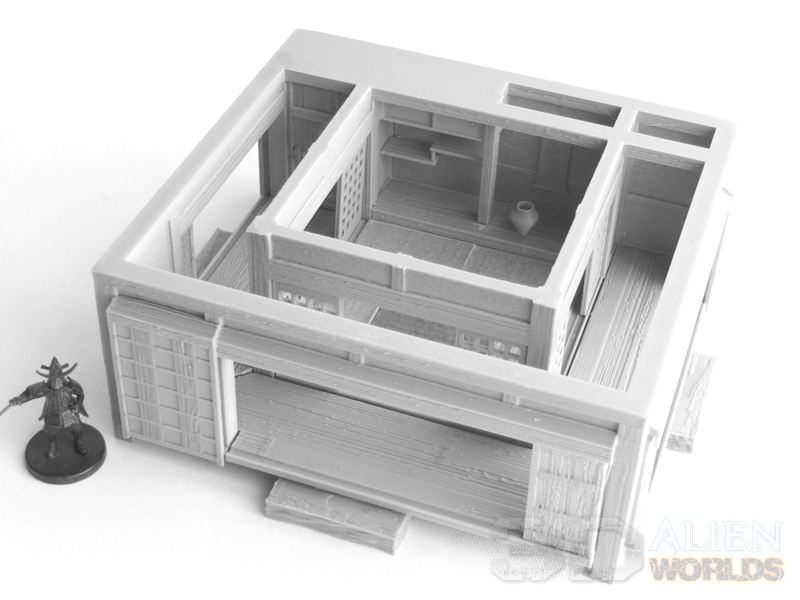
▲ Isn't that a nice interior? It's very typically Japanese, and conjures images of graceful strolls to and from the garden on a summer's night.
Work is already well underway on the main house and attached residence and kitchens, so watch this space for updates!
Last time we looked at how to assemble the outer and inner walls and gates, and this time we're moving on to some of the ancillary structures around the grounds of the new Samurai Lord's House.
These include a fancy roofed water well, 2 thick kura storehouses, and a long storehouse.

▲ Let's start with the water well! As you can see from the photo above, the water well has a pretty fancy roofed structure surrounding it, and I was able to replicate this nicely in the printed version...
▲ The structure is printed upside-down and then the two-part roof is added on top and finally the two-part well itself is placed underneath. None of these require print supports, and it's a quick and easy print.

▲ Next we are moving on to the two big storehouses. These are solidly-built, thick-walled storehouses traditionally used for keeping the possessions of the household safe from theft, and they also helped to keep the house itself relatively free from clutter. The walls are the normal wood-framed construction used on other buildings, but the exterior walls were gradually covered with up to 24 layers of clay, and the roof eaves were also similarly enclosed in clay. All of this helped to keep the storehouses safe from fire, and so the lower level was often used for rice storage, and the upper level might be used for prized possessions - furniture and ceremonial items.

▲ The print starts with a single piece (the photo example shows Storehouse #2, by the way), which includes some built-in print supports in the doorway. These print supports, highlighted in red in the photo above, should be removed with clippers.
TIP: A few of the windows have overhanging shutter boxes. These print best, I've found, if you set the slicer to print walls "Inside-to-outside" instead of "Outside-to-inside". That pretty much holds true for all of our terrain models, since dimensional accuracy of a print is less important to us than the appearance. Just a handy tip for you!
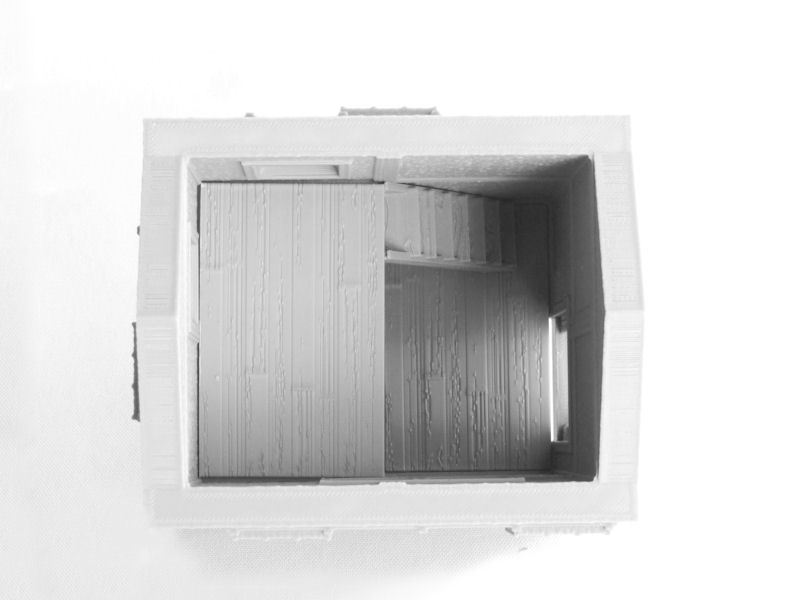
▲ Next we need to print 3 floor sections, and the stairs. These simply slot into place, but you might want to glue them into place later on rather than now, for better access when painting the interior.

▲ The doors are next, which can be connected to their hinges using spare filament (maybe clean the holes with a 2mm drill bit first) or brass rod, as shown in the photo above.
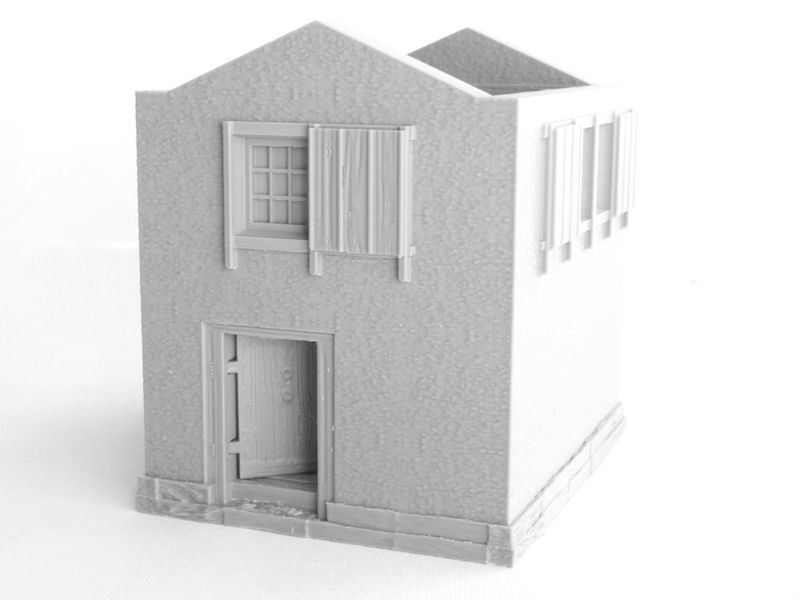
▲ Again, you might want to paint the doors before permanently attaching them to the model.

▲ You could, if you wanted, simply add a roof at this stage and call it finished, like in the photo above. But I recommend adding the small window and doorway roof pieces too, as shown in the next stage.
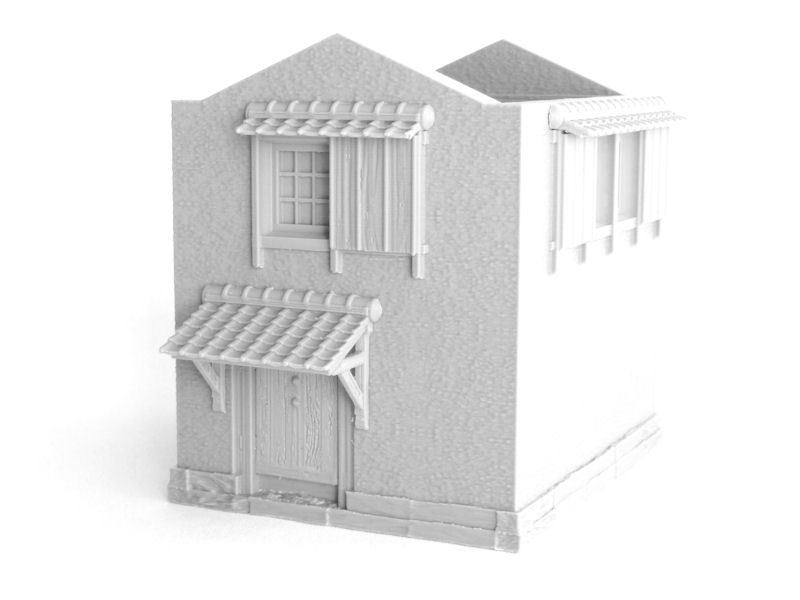
▲ These kura storehouses have small roof pieces to protect from rain over the doors and windows (called 'water-cutters' in Japanese!), and these look really unique when glued into place. 
▲ The interior of the storehouse is playable, although it's not particularly spacious. I'm planning on leaving the upper floor unglued, so it can be removed for better access during games. The rice bundle stack is included in the files, by the way.

▲ The roof prints in two halves, and completes the storehouse model. Even the roof of this very functional storehouse is pretty fancy! This version of the storehouse (Storehouse #2) has two hinged doors, one on each end of the building. Technically those were sometimes also covered in clay to make them more fire-proof, but that's a bit boring to paint, so I modelled the storehouses with wooden doors.

▲ Storehouse #1 is assembled in a similar method, but this version has a big double-door to the front of the building instead.

▲ This is the finished model of Storehouse #1. In the actual Inaba Residence that this layout is based on, this storehouse is the one right outside the kitchen, and would probably contain more foodstuffs.

▲ Our final building for today is the long storehouse shown in the photo above. This isn't as thickly-walled as the other two buildings, and has timber-beamed walls instead of clay covered ones. It's only a single-level building.

▲ The building prints in two halves, and there are three doorways that have built-in print supports (shown in red above), which should all be removed.
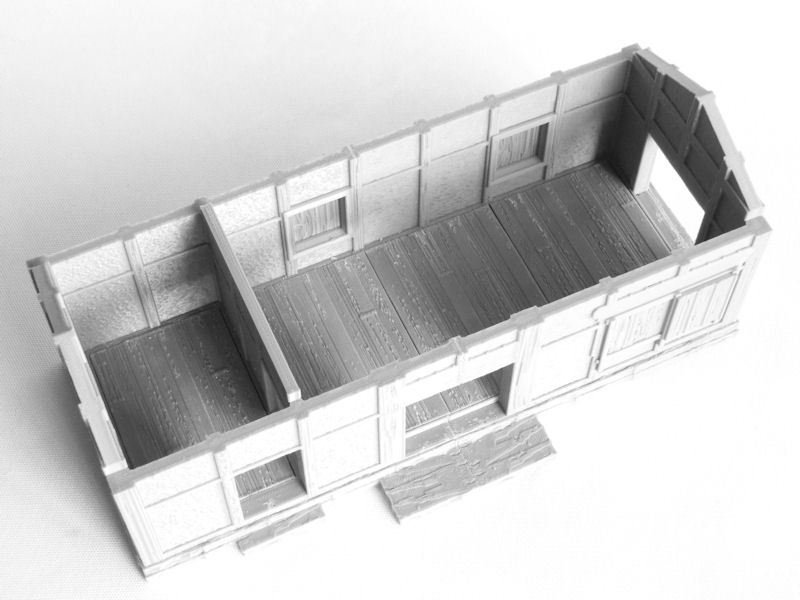
▲ There are 4 floor sections, and the slightly shorter one should be placed in the small room on the left. Again, you might want to leave these unglued until after they've been painted.
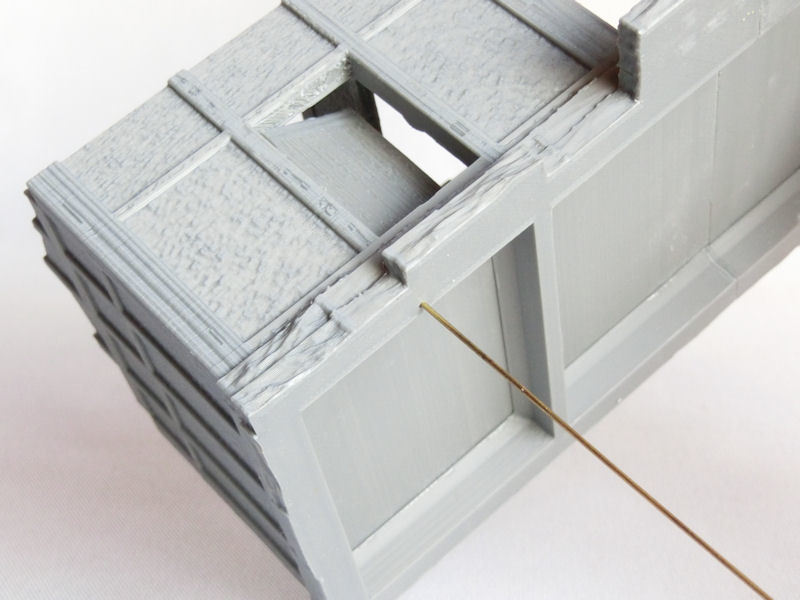
▲ The small door on the left is another hinged design, which should be connected using filament or brass rod.

▲ The other two larger doorways are both sliding door types, which can be slotted into the frame and opened and closed during play. The small grooved beams should be glued into place at the base of each sliding doorway.

▲ The long storehouse also has those cool roof pieces over the big doorways and the window at the front.

▲ The interior of the long storehouse is quite spacious, and makes a good contestable game objective, with all those entrances and exits.

▲ Here's the completed storehouse model. The roof prints in two large pieces, and includes built-in print supports for the fancy end pieces, which can be snapped off before assembly.
None of the buildings in this article require extra slicer print supports.
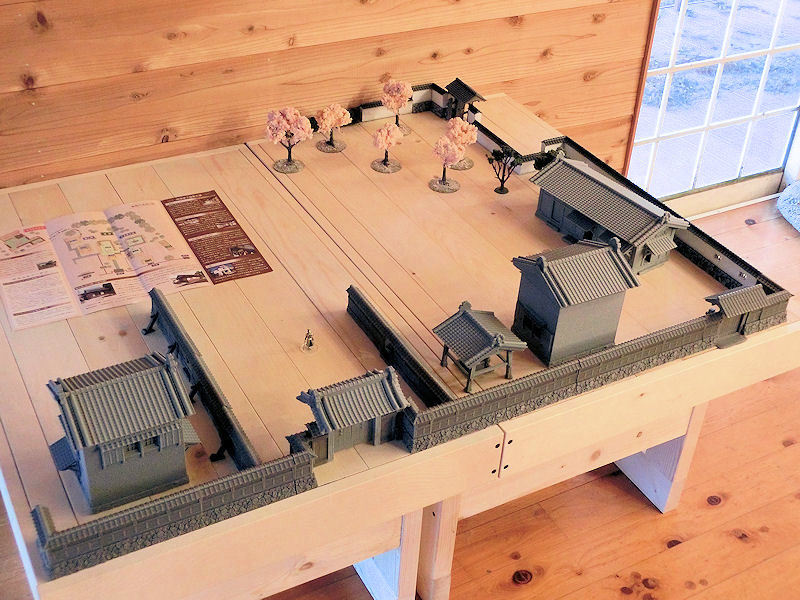
▲ One last photo to show you today - the work-in-progress pic of the whole residence layout. That's where the storehouses and water-well are located in real-life, near the outwer walls. It's looking pretty good so far, yes?
Next up will be the two guesthouses, and we'll be showing pics of those as soon as they're ready! Watch this space...

0 Comments :
Write a comment :